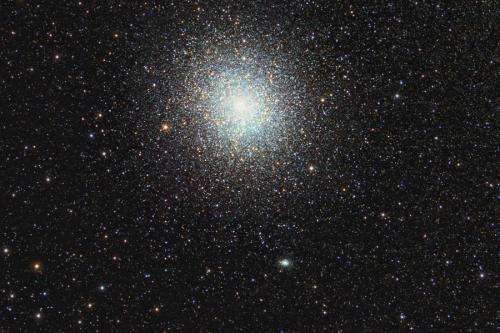The making of dust

(PhysOrg.com) -- On the Earth, dust particles are everywhere - under beds, on bookshelves, even floating in the air. We take dust for granted. Dust is also common in space, and it is found for example in the cold, dark molecular clouds where stars are born. Dust is a critical ingredient of the cosmos for several reasons. It is a repository for many chemical elements (carbon and silicon, for example). It also acts as a catalyst for the chemical reactions that produce the many complex molecules observed in space, molecules which in turn play a key role in the heating and cooling of the clouds that leads to the formation of the next generation of stars (and their planets).
Astronomers are not certain where where all of this dust comes from. Most of it is produced in the winds of stars that have finished the nuclear fusion of hydrogen and helium in their cores. These stars have made copious amounts of carbon and oxygen, begun to swell in size, and blown off material that condenses into dust grains. But numerous puzzles remain, including the nature of the grains (composition, size, shape), precisely when the process begins and ends in stars of different masses, and how formation depends on element enrichment in the parent star.
One way to address many of these problems is by looking at evolved stars in a single globular cluster; all of the stars in a globular cluster are about the same age and composition, and differ primarily in their masses. CfA astronomer Joe Hora and Tom Robitaille have joined with thirteen colleagues to analyze the dust production in 47 Tucanae, the nearest (about fifteen thousand light-years away) and one of the most massive (almost a million solar masses) globular clusters. The scientists combined optical data with infrared measurements from the Spitzer Space Telescope to model the statistical nature of 47,727 stars in the inner part of the cluster. Since the team was concentrating on the issue of dust and its infrared contribution to a star's radiation, they narrowed the full list to 258 stars with clear signs of dust emission.
The astronomers reach several important conclusions in their study. First, in disagreement with some earlier work, they find that only the brightest few percent of the stars produce dust, and virtually all stars brighter than about 2000 solar luminosities make dust. They also find that the initial stellar composition does not appear to be an important factor in dust production, an important conclusion when considering dust production in the early epochs of the universe. Not least, they refine the age of the cluster as 12 +-1 billion years, and its distance as 15,032 +- 650 light-years.
Provided by Harvard-Smithsonian Center for Astrophysics




















